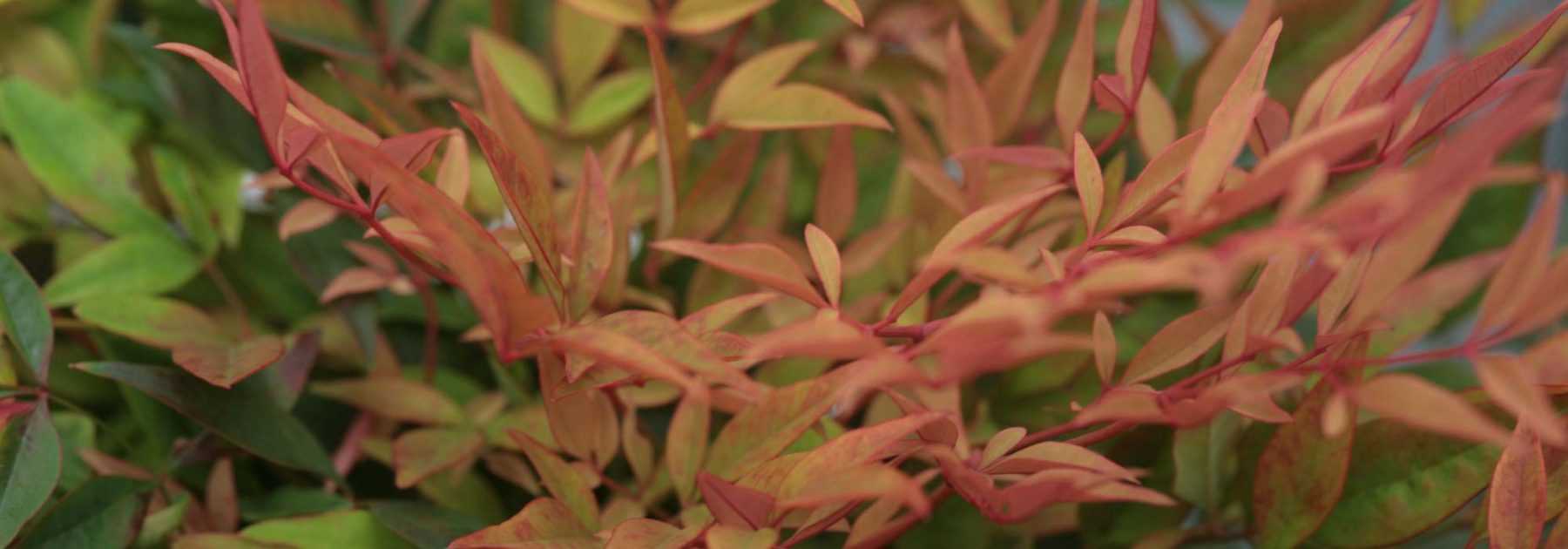
Sacred Bamboo, Nandina domestica: planting, pruning, care
Contents
The Sacred Bamboo in a few words
- The nandina or “Sacred Bamboo” is a bush with remarkable evergreen foliage, changing with the seasons from red to green and finally turning purple
- Its generous summer flowering, in large white panicles, is fresh and subtle
- It’s equally stunning in late season, covered with small, shiny red berries
- Accommodating, it withstands summer drought well and proves hardy down to -12/-15°C
- Versatile and highly graphic, it’s ideal in small shrub beds or in pots in partial shade
Our expert's advice
The Nandina, also known as the “Sacred Bamboo”, is one of the few bushes with evergreen foliage that changes colour throughout the seasons, shifting from red in spring to green in summer, and finally turning reddish-orange to purple in autumn. It offers all the shades of autumn foliage without shedding!
Compact in size, Nandina domestica can reach a height of 60 cm to 2 m depending on the variety. There are even dwarf nandinas that stay under 60 cm in all directions, making them perfect for rockeries, ground cover, or containers.
Whether it’s Nandina domestica ‘Fire Power’, ‘Richmond’, ‘Obsessed’, or ‘Gulf Stream’, each one continuously creates a joyful and ever-changing scene in the garden.
Hardy down to -15°C, nandina withstands frost well if sheltered from wind and adapts to all soil types, even poor and stony ones, though it prefers fresh, fertile, and well-drained soil.
Its relatively slow growth, resistance to pollution, and modest size make it a must-have for all gardens—whether coastal, urban, or small spaces where it adds a hint of Japanese charm.
Versatile and gracefully elegant, it fits perfectly in flower beds, cool rockeries, as a standalone feature, in informal hedges, or even in zen-inspired compositions, and will look stunning in large containers on a terrace with non-scorching exposure.
Discover our Sacred Bamboos—hardy and resilient bushes that are still underappreciated yet adaptable to any vision. They will bring originality, lightness, and elegance to your garden throughout the seasons.
Description and botany
Botanical data
- Latin name Nandina domestica
- Family Berberidaceae
- Common name Sacred bamboo, heavenly bamboo
- Flowering From July to September
- Height 0.60 to 2 m
- Exposure Sun, partial shade
- Soil type All types, well-drained
- Hardiness -15°C
The Nandina domestica, also known as “Sacred Bamboo” (“Heavenly Bamboo” or “Bamboo of Happiness”) is an evergreen bush native to the wooded regions of India, China and Japan, belonging to the Berberidaceae family like the barberry or Berberis. While it resembles bamboo in its stem structure, the similarity ends there – despite its nickname, it has no botanical relation to bamboo and doesn’t belong to the same family.
The Nandina genus contains only one species, domestica, which has given rise to about sixty cultivars in Japan, few of which have been imported to our European gardens. Only a handful like ‘Richmond’, ‘Obsessed’, ‘Fire Power’ or ‘Gulf Stream’ are cultivated in our latitudes.
This bush has a particularly dense, upright and compact habit with a beautifully rounded silhouette. With relatively slow growth, this rhizomatous plant grows entirely in stems like bamboo. The Sacred Bamboo forms a clump of thin, upright stems that branch out from a cespitose stump. They can reach up to 1.80 m in height.
Nandina needs several years to become sufficiently bushy. It propagates easily by seeds and suckering. Some dwarf or low-growing varieties (‘Fire Power’) make excellent ground cover. Its bark is aromatic.
Sacred Bamboo stands out for its beautiful, ample and colourful foliage that persists through winter, brightening the garden all year round. Its light, seasonally changing foliage is the precious asset of this remarkable bush. Evergreen or semi-evergreen, it creates a background of greenery with great delicacy that’s attractive all year. The Sacred Bamboo will only lose its leaves if temperatures drop below -15°C.
The pinnate, lanceolate or elliptical leaves are finely divided into narrow, pointed leaflets of 2.50 cm. Depending on the variety, the foliage may be tapered or curly. Nandina domestica ‘Filamentosa’ has extremely fine, spiderweb-like foliage.
This light foliage reminiscent of bamboo earned Nandina the common names of “Sacred Bamboo” or “Wonderful Bamboo”.
This dense yet slender vegetation forms broad horizontal umbrellas, 50 to 90 cm long.
Leaf colours vary by cultivar. Nandina domestica ‘Twilight’ has light green foliage variegated with creamy white, while ‘Lemon Lime’ has spring foliage in chartreuse to lime green.
With each season change, their colours evolve as they develop; pink-red to pink-orange during bud burst, they green up in summer ranging from acid green, bronze green to blue-green, then adorn themselves in yellow, orange, red by season’s end. These flamboyant autumn hues intensify with the cold.
Its summer flowering is subtle. From July to September, large loose panicles 30 to 40 cm long appear, composed of tiny cream-white flowers. With a beautiful waxy texture, they bear large yellow anthers that stand out against this light cloud.


Various foliages: Nandina domestica ‘Twilight’, Nandina domestica ‘Lemon Lime’, Nandina domestica ‘Filamentosa’, Nandina domestica ‘Obsessed Seika’.
Depending on variety, these are followed in autumn by abundant clusters of shiny red fruits 4 to 8 mm in diameter. Some cultivars rarely seen here bear yellow or white berries. Nandina offers one of the most abundant and long-lasting fruitings, especially after a hot summer.
Very decorative, these scarlet berries persist long on the branches, from winter until spring, remaining in harmony with the autumn-reddened foliage before mingling with new spring shoots, or even the next flowering.
Graphic flowering or fruiting branches are used in Ikebana arrangements.
Originally, Nandina is a dioecious plant, meaning fruiting only occurs if male and female plants grow side by side. Today there are hermaphroditic varieties (‘Richmond’) that are more fruitful, capable of producing berries abundantly even without a male plant nearby. Others like Nandina domestica ‘Lemon Lime’ or ‘Fire Power’ bear little or no fruit.
Though non-edible and toxic to humans (they contain nandenine), these drupes will nevertheless delight certain birds during the harsh season.
Although relatively hardy (down to about -15°C), Sacred Bamboo prefers mild winters. It thrives almost everywhere in France – it’s a very easy bush to grow, particularly in coastal gardens.
It grows in partial shade or sunny positions, in ordinary soil, rich or poor, neutral or acidic, fresh and well-drained, and especially sheltered from harsh cold and drying prevailing winds which it fears.
With its elegant evergreen foliage and compact size, Nandina is valuable for brightening shady shrub borders, rockeries in dappled shade or perennial beds. It can also be planted in low mixed hedges. This small bush will also look magnificent in a large pot on the terrace in non-scorching exposure, or as a conservatory or winter garden plant in cold regions.
In Asia, Sacred Bamboo has been cultivated for centuries, planted around temples or to adorn their altars – it’s one of the sacred plants symbolising purification.
Sacred Bamboo has medicinal properties – astringent, sedative – used for centuries in Asian pharmacopoeia.
Read also
Take extra care of your evergreen shrubsMain species and varieties
There is only one species of Sacred Bamboo, the Nandina domestica, but it comes in around sixty cultivars with highly variable colours and sizes, still very rarely imported here. ‘Richmond’ with abundant fruiting, ‘Obsessed’, ‘Fire Power’ with a very compact habit, or ‘Gulf Stream’ are among the small selection of varieties with changing foliage throughout the months, offered for ornamental use in our gardens. Not all varieties are hermaphroditic: the Sacred Bamboo will be more fruit-bearing if at least two individuals are planted in the garden!
Some compact varieties like the dwarf nandinas (‘Fire Power’) work well as ground cover and are more suited to pot cultivation on a shaded terrace, reaching only about 60 cm in height, while others can grow up to 1.80 m tall (‘Plum Passion’).
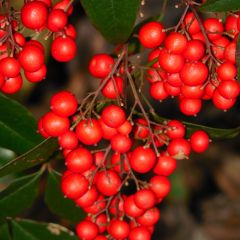
Nandina domestica Richmond - Sacred Bamboo
- Flowering time July to September
- Height at maturity 1,60 m
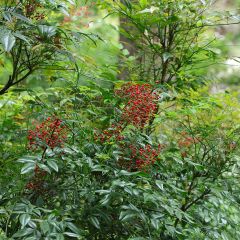
Nandina domestica - Sacred Bamboo
- Flowering time July to September
- Height at maturity 2 m

Nandina domestica Fire Power - Sacred Bamboo
- Flowering time July to September
- Height at maturity 60 cm
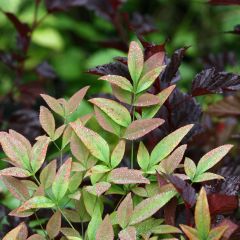
Nandina Obsessed Seika - Sacred Bamboo
- Flowering time July to September
- Height at maturity 1 m
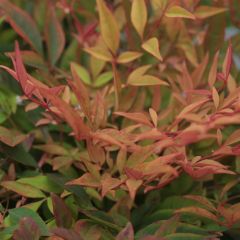
Nandina domestica Gulf Stream - Sacred Bamboo
- Flowering time July to September
- Height at maturity 1 m
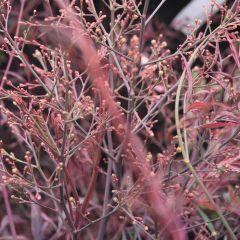
Nandina domestica Plum Passion - Sacred Bamboo
- Flowering time July to September
- Height at maturity 1,20 m
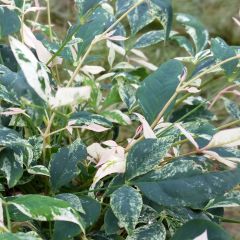
Nandina domestica Twilight - Sacred Bamboo
- Flowering time July to September
- Height at maturity 1,20 m
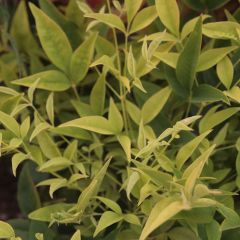
Nandina domestica Lemon Lime - Sacred Bamboo
- Flowering time July to September
- Height at maturity 70 cm
Discover other Nandina
View all →Available in 1 sizes
Available in 4 sizes
Available in 3 sizes
Available in 1 sizes
Available in 1 sizes
Available in 1 sizes
Available in 1 sizes
Available in 1 sizes
Available in 1 sizes

Available in 4 sizes
Planting
Where to Plant Nandina or Sacred Bamboo
The Nandina or Sacred Bamboo can be planted almost anywhere in France, except in regions with harsh winters and in the south of France, as it does not appreciate extreme heat. It thrives in mild winters and summers that are not too hot.
With good hardiness, it is capable of withstanding temperatures down to -15°C for short periods if sheltered from icy, drying winds: planting in a spot protected from extreme cold is essential. It grows well up to the Paris region. In colder areas, severe frosts may cause its beautiful coloured foliage to drop and damage its new spring shoots.
In harsh climates, it is entirely possible to grow Nandina in a pot and overwinter it in a conservatory or winter garden.
It dislikes heatwaves and prolonged drought when young, but once established, it becomes fairly resistant to summer heat if the soil is deep.
Nandina enjoys sunny or lightly shaded spots but never scorching ones. South of the Loire, it can tolerate occasionally dry soil with good mulching. In Mediterranean climates, it’s best to give it a shaded spot, especially for variegated varieties, which are more sensitive to burning sun.
Avoid deep shade, as it needs light to maintain vibrant foliage. However, its evergreen foliage tolerates urban pollution and sea spray well, making it an excellent choice for city gardens, where it is widely planted, and for coastal areas.
While it adapts to most ordinary, well-drained soils, even poor or slightly chalky ones, it prefers rich, slightly acidic soil that stays moist in summer.
The Sacred Bamboo grows slowly, rarely exceeding 2m in height at maturity, making it a compact bush ideal for small gardens.
In larger gardens, it looks stunning when planted in groups of 3 to 5 specimens in expansive arrangements. Fruiting will be even more abundant if you plant at least two Nandinas in the garden!
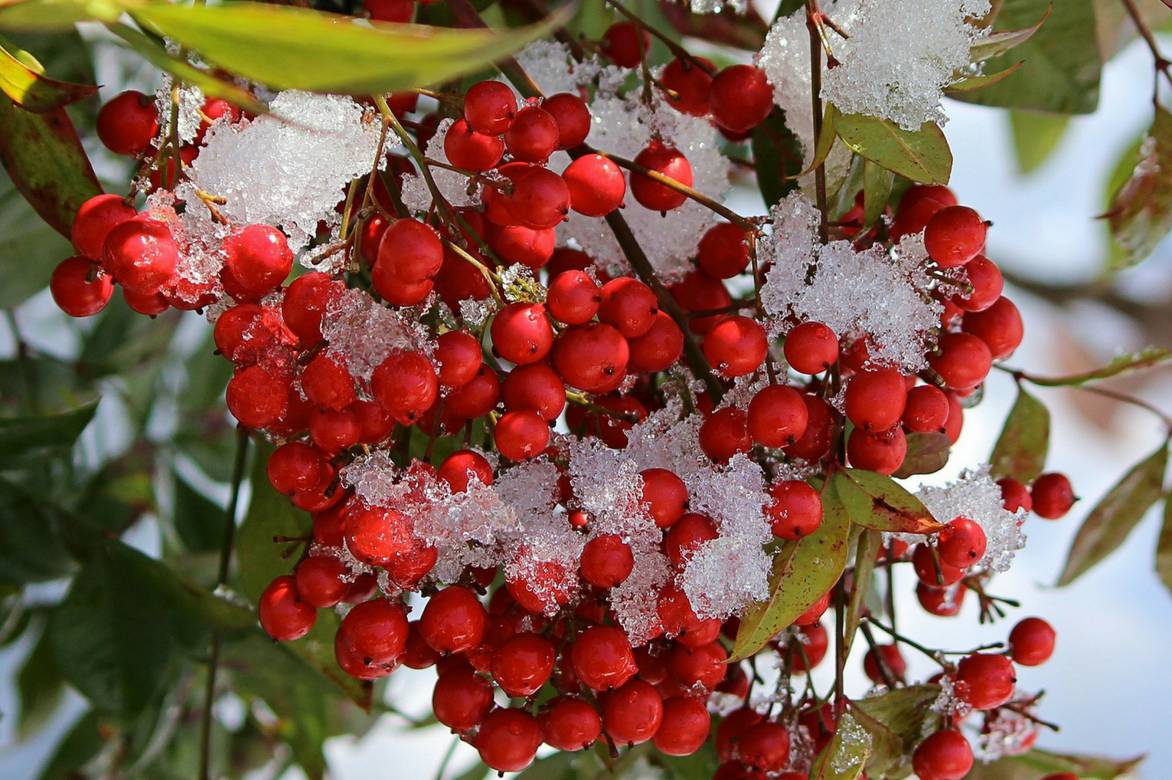
Fruiting of a Nandina.
Highly versatile, this beautiful bush works well in borders to enhance a cottage-style bed, alongside perennial plants, or in a semi-shaded rockery. With its dense, colour-changing foliage, it can also be planted as a low hedge or at the front of a flowering or mixed hedge, providing privacy—though it should not be used as a windbreak.
Its compact growth also makes it suitable for growing in large pots on a terrace or balcony.
When to Plant Sacred Bamboo
The Nandina, sold in containers, can be planted year-round, avoiding frost and drought periods. Ideally, to encourage establishment, plant in autumn, from September to November in warm regions, and in spring from March to May elsewhere.
How to Plant Nandina or Sacred Bamboo
In the ground
It prefers deeply worked soil. Use it in borders, in groups of 3 or 5 specimens, or in informal hedges. Space plants 1.20 to 1.50m apart for larger varieties and 0.50 to 0.60m for dwarf sacred bamboos.
- Dig a hole 3 times wider than the pot
- Loosen the soil well
- Add a layer of pumice or gravel at the bottom
- Mix garden soil with equal parts turf, compost, or potting mix
- Plant the bush at collar level
- Backfill, keeping the bush upright
- Firm the soil around the base
- Water thoroughly
- Mulch to retain moisture
- Monitor watering for the first two years
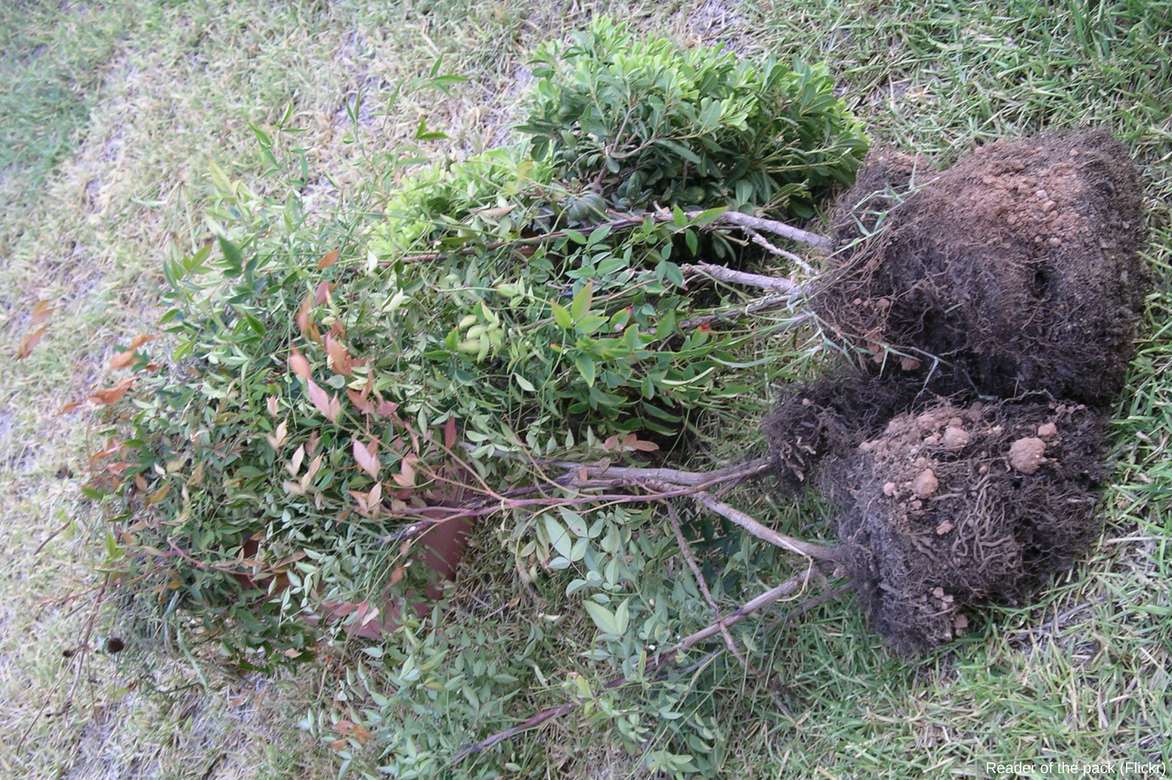
Transplanting a Nandina
Growing Sacred Bamboo in a Pot
Choose compact varieties like ‘Fire Power’ and a pot 20–30cm in diameter.
- Add a drainage layer (gravel or clay pebbles)
- Use a mix of rich shrub compost and turf
- Mulch the base
- Water the Nandina in a pot regularly, especially in summer when the soil dries out
- Place the pot indoors or on a sheltered terrace away from direct sun and strong winds
→ Learn more in Growing Nandina in a Pot: Our Tips and Which Nandina or Sacred Bamboo to Choose for Your Garden or Terrace?
Pruning and maintenance
Easy to grow, the Nandina requires little care and maintenance. Ensure it does not lack water during its first few summers.
Plan for regular watering during the first two years after planting to help it establish. Once well-established, Nandina domestica tolerates drought fairly well and won’t need watering, except during prolonged dry spells. Excess water could cause the roots to rot.
However, potted Nandinas have greater water needs; water regularly, especially in summer, and mulch each year in spring.
In regions with very harsh winters, each autumn, spread a thick mulch of dead leaves, compost, partially decomposed manure, or bark mulch around the base of the bush to protect its roots from the cold.
For potted Sacred Bamboos, refresh the top layer of compost each autumn.
When and How to Prune Sacred Bamboo?
Pruning is not essential but involves cutting back stems damaged by winter frost or spent flowers. It helps maintain a lovely bushy and compact shape, stimulates the production of new shoots at the base, ensures continuous renewal of stems, and thus rejuvenates the plant.
Simply remove dead or dried wood, overcrowded branches, and weak shoots, and lightly trim stems that disrupt symmetry.
- Do not prune too early in winter, as stems may freeze—wait until after frosts in March-April, once the berries have fallen
- If the bush’s upper parts have been damaged by frost, cut it back to ground level—it will regrow from the base
Diseases and potential pests
The Nandina proves to be particularly hardy, is not often parasitic and withstands pollution well. However, in urban areas, it may suffer from scale insect attacks: spray rapeseed oil to smother the pests.
It can be more prone to disease, a virus spread by aphids and sap-sucking or piercing pests, which makes the leaf narrower, stunted and misshapen, but it will survive without issue: watch for aphid infestations and apply regular sprays of soapy water.
Propagation
While sowing is possible through cold stratification, it is a lengthy and uncertain process. You can easily propagate Nandina by dividing suckers or taking semi-ripe stem cuttings.
By dividing suckers
- In spring, using a spade, carefully separate suckers with roots from a vigorous parent plant
- Replant immediately in a bucket placed in a cool, partially shaded spot until established
- Ensure thorough watering
- Transplant into the ground the following autumn
Semi-ripe cuttings
- Between mid-July and September, take 8-10 cm stems from lower branches where the base is semi-ripe (harder and woody)
- Remove lower leaves, keeping those at the top
- Dip the base in plant hormone for cuttings
- Plant cuttings in a bucket filled with a moist mixture of river sand and compost
- Protect from frost over winter in a humid environment until rooting occurs (this is slow)
- Keep in a bucket for two years before transplanting cuttings into the ground
Pairing Sacred Bamboo in the Garden
With its airy and ever-changing leaf, the Sacred Bamboo plays wonderfully with wind and light, brightening up dull areas of the garden throughout the seasons. It is invaluable in a coastal garden or, as it is pollution-resistant, it is also perfect for urban gardens. It will integrate well into a mixed hedge or a flowering shrub border, in a low-maintenance garden, from the most classic to the most Japanese-inspired.
In hedges, it pairs beautifully with all types of bushes such as Tree Peonies, Mountain Laurels, and complements other acidophilous plants like Camellias, Rhododendrons, Hydrangeas, and Andromedas, whose silhouette it will lighten.
Nandinas fit equally well in contemporary gardens as in wild-looking gardens, forming stunning autumn scenes with ornamental grasses such as Pennisetum and Stipa tenuifolia.

An example of contemporary pairing: Pennisetum alopecuroides f. viridescens, Nandina domestica, Stipa tenuifolia.
In a mixed flowering hedge, it can be paired with Deutzia, a golden-leaved Japanese Spirea, a Pheasant Berry like Leycesteria formosa ‘Purple Rain’, a Viburnum or a Butterfly Bush, or even accompanied by shrub roses and Mexican Orange Blossom.
The elegance of its habit deserves to be showcased among smaller plants that won’t obscure its silhouette. This makes it ideal for placing in front of taller bushes, such as ceanothus or dogwoods.
You can mix several varieties of Nandina for a striking effect in a hedge or border.
In a Japanese-inspired planting, focusing primarily on foliage effects, Japanese Maples and Spindle Bushes with mahogany hues, along with bamboos, will echo the berries and bronze- or purple-tinged leaves of the Sacred Bamboo.
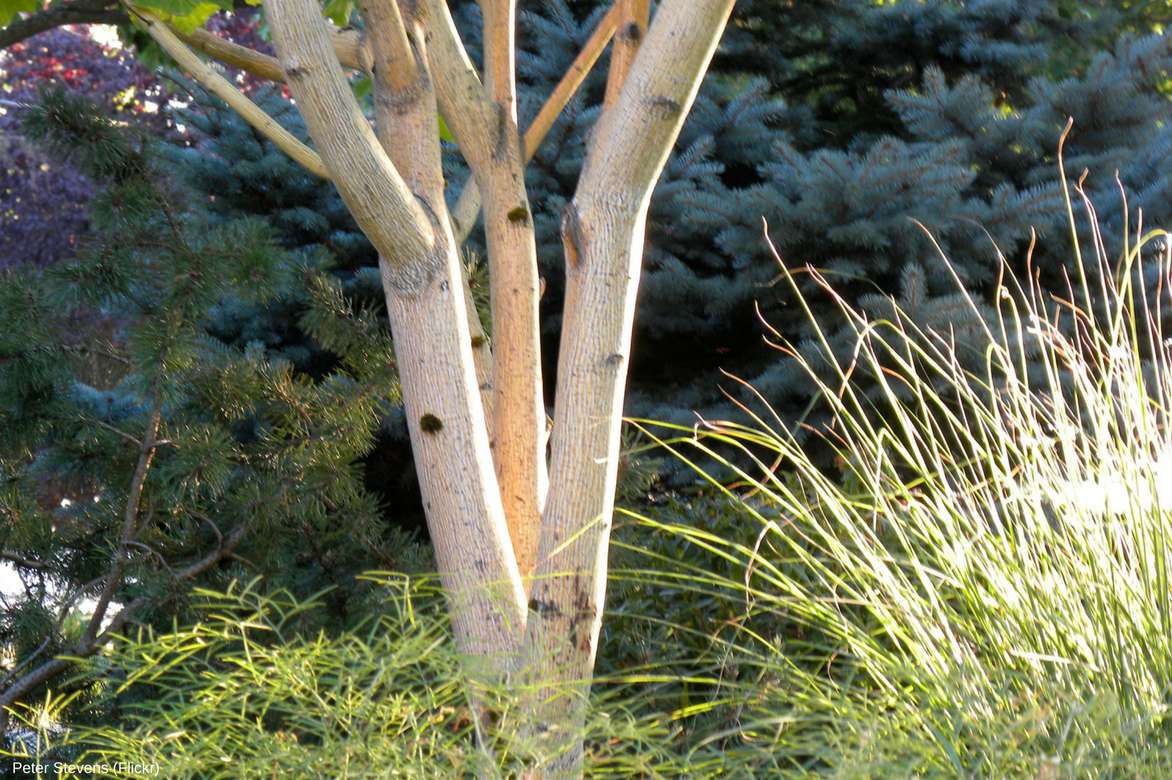
An example of pairing: Acer pensylvanicum, Nandina domestica ‘Filamentosa’, Miscanthus sinensis ‘Afrika’, Picea pungens ‘Glauca Globosa’
Placed at the back of a border, it pairs easily with perennials like rudbeckias, euphorbias, crocosmias, daylilies, or opulent summer flowers such as dahlias. Chinese Lanterns and Loosestrifes also make excellent herbaceous companions. Chrysanthemums in fiery tones and heleniums will take over the display later in the season.
In autumn, its flamboyant leaf will harmonise perfectly with the Cercidiphyllum japonicum (Katsura Tree), Smoke Bushes, sumacs, rowans, witch hazels, linderas, deciduous azaleas, or Stephanandra tanakae and Leucothoes, whose highly ornamental leaves evolve alongside it through the seasons.
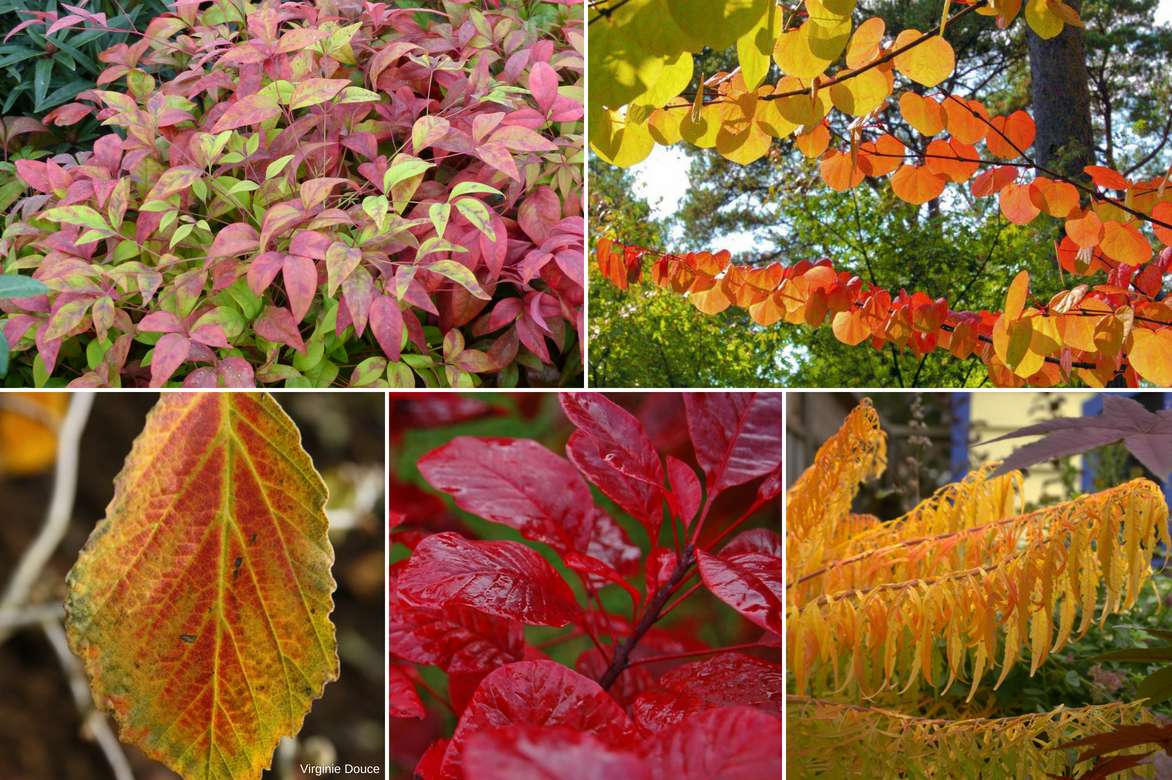

An autumn pairing idea: Nandina domestica ‘Gulf Stream’, Cercidiphyllum japonicum, Hamamelis intermedia ‘Jelena’, Cotinus ‘Grace’, Rhus typhina ‘Tiger Eyes’.
Its decorative red berry display will complement that of Cotoneasters or Crab Apples, Barberries, and Beautyberries.
Dwarf varieties planted at the front of a border will pair beautifully with Heucheras.
Plant early daffodils and late tulips at the base of the bush to create delightful colour surprises—these bulbs will accompany the Sacred Bamboo from early spring through to its flowering.
Useful resources
Discover:
- our collection of Sacred Bamboos: the most beautiful Nandina varieties are in our nursery!
- Also explore our articles: “Sacred Bamboo: the most beautiful Nandinas to grow in pots” and Nandina domestica: a reliable choice among decorative foliage plants.
- Like the Sacred Bamboo, these bushes thrive in dappled shade: choose from these flowering plants for shade
- Some stunning plant pairings with Nandinas
- The Nandina domestica in video
- Find our tips on how to properly water a potted bamboo.
- Subscribe!
- Contents
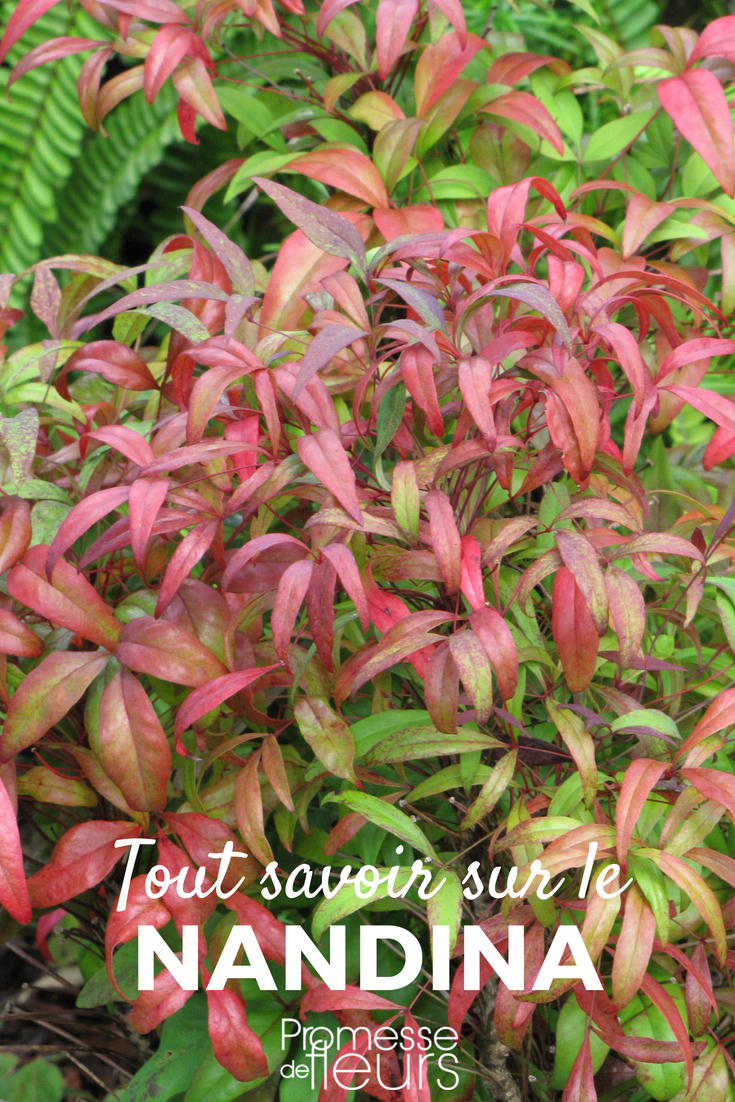


































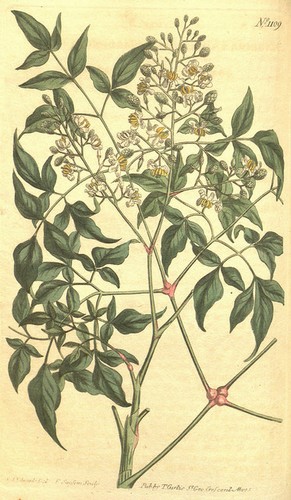

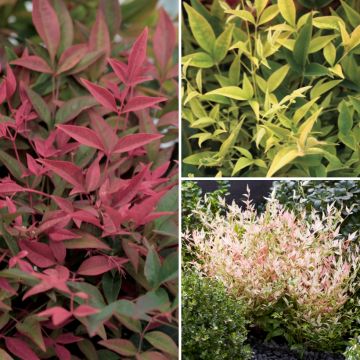


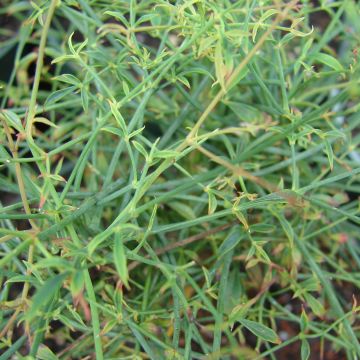
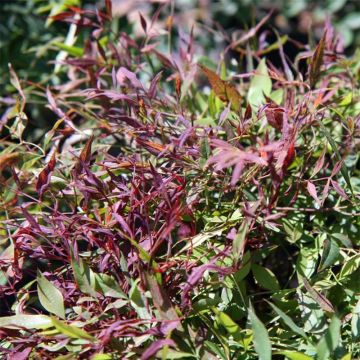
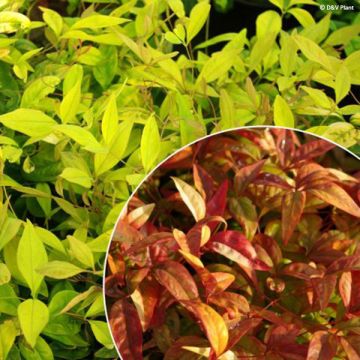
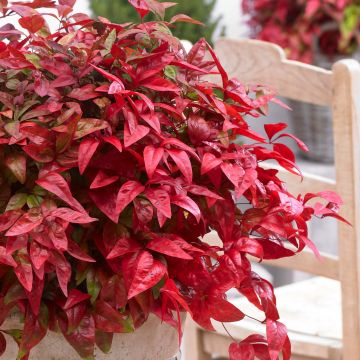


Comments